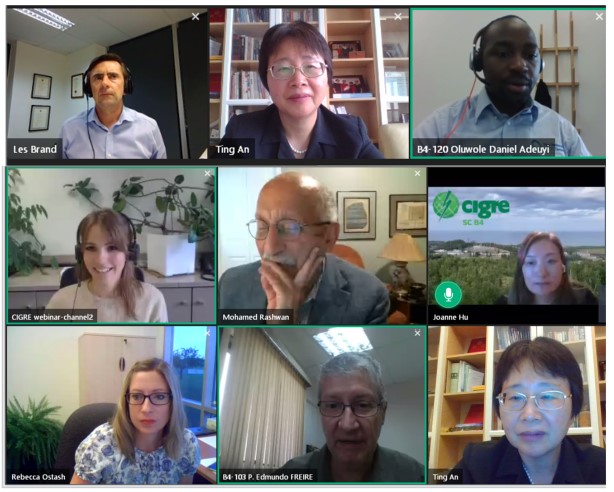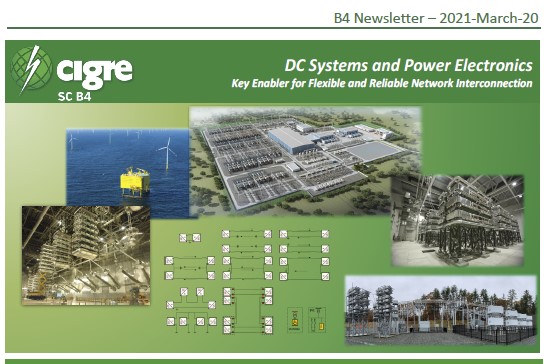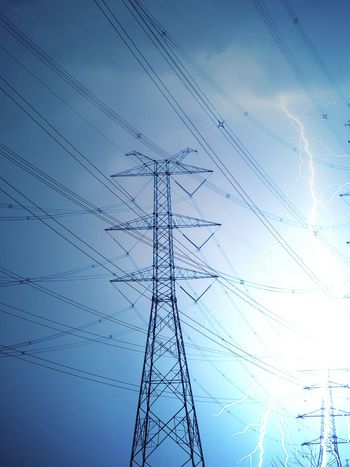DC Systems and Power Electronics
By Joanne Hu, Chair & Rebecca Ostash, Secretary
Introduction
DC systems and power electronic based devices are not only a key enabler but also an insurer for building up reliable, flexible, complex, economic, and green power system networks with distinctive features of Decentralization, Decarbonization and Digitalization. Although Covid-19 pandemic has drastically changed the whole world, we are gradually adapting to the new normal and continued to progress with our spirit and positive attitude.
Study committee B4 is organized very well the same as all Study Committees. It has 24 regular members, 4 additional members to cover distribution issues related to the Study Committee, and 12 observers. The Study Committee has 542 experts from 37 countries actively involved in 22 Working Groups including 42 women.
Scope of work
The scope of SC B4 covers DC systems and Power Electronics (PE) equipment for AC systems which includes DC equipment for UHVDC, HVDC, MVDC and LVDC. The Study Committee also addresses DC systems and equipment as well as Power Electronics for other applications such as distribution, and power quality improvement. DC converters for energy storage are part of the activities of SC B4. The members of SC B4 come from transmission system operators (TSOs), manufacturers, utilities, distribution system operators (DSOs), consultants, universities and research institutes.
The Study Committee activities cover the full spectrum of DC systems and PE devices including specification, design, implementation, operation, maintenance, refurbishment of DC, FACTS and power electronic devices in both transmission and distribution systems. SC B4 also actively cooperates with other Study Committees when the joint effort and knowledge sharing are involved to achieve the best outcome of the Study Committee work.
Working Group activities
The growth of renewable energy and retirement of conventional large synchronous machines has brought new technical challenges such as the need for optimized reactive power control schemes, operation under low short circuit level conditions as well as the reduction in inertia coupled with the inherently low inertia available with wind/solar generation. The development of power electronics devices has allowed the power industry to rise to the challenges and network issues encountered to date and is capable of addressing foreseeable challenges within the power industry.
SC B4 established four (4) new Working Groups to continue to tackle these technical issues and to enhance the existing technologies as well as the performance of DC systems and FACTS devices.
B4.89 - Condition Health Monitoring and predictive maintenance of HVDC Converter Stations
SC B4 has mainly focused on availability and more work is needed in SC B4 on condition monitoring and predictive maintenance for HVDC systems while considering the latest technology improvements. This WG will work toward identifying and qualifying the indicators to help the decision making of facilities owners to develop/implement optimized station maintenance strategy (i.e. in response to the detected components degradation to decide on the follow-up such as refurbishment, replacement, possible life extension measures in comparison to the maintenance cost and the operation needs). Based on the findings, recommendations with included selected case studies will be prepared.
B4.90 - Operation and Maintenance of HVDC and FACTS Facilities
A significant amount of operational experience has been gained in the operation and maintenance (O&M) of HVDC facilities and FACTS, but there is very little detailed information available in the public domain documenting this experience. O&M of HVDC systems have been addressed at fairly high level by IEC. However, there is lack of the detailed experiential information and practical requirements for the establishment and performance of the O&M functions and the presentation of options and alternatives and guidelines on how to establish a fully functioning O&M system for an HVDC system.
This WG will collate and evaluate the 60+ years of operational experience, covering LCC and VSC technologies and all equipment types and develop easy to follow guidelines for the O&M of HVDC and FACTS facilities. These guidelines will include a description of the essential O&M requirements for each type of equipment found within HVDC converters and FACTS facilities and provide good practice recommendations on how the O&M requirements can be met. The guideline would also provide information on the required skills and expertise, where and how these are typically acquired and suggest strategies for providing the required skills, expertise and support for new HVDC and FACTS projects and facilities as well as a roadmap on how this can be achieved in time for the HVDC or FACTS facility’s first operations.
B4.91 - Power-electronics-based transformer technology, design, grid integration and services provision to the distribution grid
Power electronics-based transformers (PET), also referred to as Solid-State Transformers or Smart Transformers, allows better grid controllability and facilitate the integration of green energy resources, limiting or deferring the infrastructure upgrade. PET does not only perform the voltage conversion function as conventional transformers but also provides other services to the distribution grid, such as voltage and power flow control, conservation voltage reduction, variable voltage and frequency profiles, and power quality improvement. Moreover, it enables a DC supply for direct connection of DC resources (e.g., electric vehicle charging stations), both at low and medium voltage levels.
Several prototypes of PET are currently developed and tested in the world. However, there are no guidelines, standards or grid connection rules for designing and integrating PET in the distribution grid. This WG will focus on providing guidelines for the PET design as well as its grid integration, and on grid services capabilities.
B4.92 - STATCOMs at Distribution Voltages
Power electronics-based STATCOMs allows better grid controllability and facilitate the integration of green energy resources, limiting or deferring the infrastructure upgrade. PE-based STATCOMs provide dynamic injection and absorption of reactive power into the distribution system, which enhance the distribution grid with more flexible and reliable voltage control and power quality improvement including damping of flicker and harmonics control as compared to other device such as capacitors.
A number of distribution STATCOMs (D-STATCOM) are currently being developed and installed around the world in countries such as USA, Canada and UK. It would be necessary and beneficial to collect and evaluate the design and operational experience gained from these newly developed distribution STATCOMs and prepare general guidance for the future application of STATCOMs in distribution systems. This WG will focus on providing guidelines for the D-STATCOM grid integration and grid services capabilities based on and with reference to existing service experience.
Completed Working Groups
Six (6) Working Groups including one Joint WG completed their work and published Technical Brochures.

Active Working Groups and Joint Working Groups
SC B4 has twenty-two (22) active Working Groups including seventeen (17) B4 WGs and five (5) Joint WGs with other SCs as well as one Joint Task Force.
| B4.64 | Impact of AC System Characteristics on the Performance of HVDC schemes |
|---|---|
| B4.69 | Minimizing loss of transmitted power by VSC during Overhead line fault |
| B4.71 | Application guide for the insulation coordination of Voltage Source Converter HVDC (VSC HVDC) stations |
| B4/B1/C4.73 | Surge and extended overvoltage testing of HVDC Cable Systems |
| B4.74 | Guide to Develop Real Time Simulation Models (RTSM) for HVDC Operational Studies |
| B4.75 | Feasibility Study for assessment of lab losses measurement of VSC valves |
| B4.78 | Cyber Asset Management for HVDC/FACTS Systems |
| B4.79 | Hybrid LCC/VSC HVDC Systems |
| B4/A3.80 | HVDC Circuit Breakers - Technical Requirements, Stresses and Testing Methods to investigate the interaction with the system |
| B4.81 | Interaction between nearby VSC-HVDC converters, FACTs devices, HV power electronic devices and conventional AC equipment |
| B4.82 | Guidelines for Use of Real-Code in EMT Models for HVDC, FACTS and Inverter based generators in Power Systems Analysis |
| B4.83 | Flexible AC Transmission Systems (FACTS) controllers’ commissioning, compliance testing and model validation tests |
| B4.84 | Feasibility study and application of electric energy storage systems embedded in HVDC systems |
| B4.85 | Interoperability in HVDC systems based on partially open-source software |
| C4/B4.52 | Guidelines for Sub-synchronous oscillation studies in power electronics dominated power systems |
| B4/A3.86 | Fault Current Limiting Technologies for DC Grids |
| B4.87 | Voltage Source Converter (VSC) HVDC responses to disturbances and faults in AC systems which have low synchronous generation |
| TF B4/B1.88 | Insulation coordination procedure for DC cable systems in HVDC stations with Voltage Source Converters (VSC) |
| B4.89 | Condition Health Monitoring and predictive maintenance of HVDC Converter Stations |
| B4.90 | Operation and maintenance of HVDC and FACTS Facilities |
| B4.91 | Power-electronics-based transformer technology, design, grid integration and services provision to the distribution grid |
| B4.92 | STATCOMs at Distribution Voltages |

CIGRE active Working Groups / Call for experts
Green Books progress
GB on FACTS
The “Flexible AC Transmission Systems” commonly referred to as FACTS has been published in the CIGRE Green Book series in July 2020. This two-volume inspiring book is the major milestone of a 4-year effort to produce a comprehensive treatise about the available options for improved utilization of existing AC transmission lines as well as the opportunities to reduce the capital expenditures for new AC transmission lines. The book has 24 chapters with 1100 pages, including 600 figures, and 71 tables, covering many different topics associated with FACTS technologies.

The Green Book is available for purchase on our partner's website Springer.
If you are a CIGRE Member, please contact us to benefit from a 40% discount on your purchase.
GB on HVDC
B4 has kicked off another Green Book on “High Voltage DC Transmission Systems”. The proposal was approved by TC on December 6th, 2020 and by Springer on Dec 23rd, 2020. The Green book is under development.
Tutorials and workshops in 2020/2021
B4 delivered a number of Tutorials/workshops in 2020, three at the Paris e-Session and a series of tutorials to support CIGRE India.
Paris e-session
| Aug. 24 | A3/B4 Workshop | Meshed offshore HVDC transmission grid development |
| Aug. 24 | Workshop | Interaction assessment of VSC-HVDC links using EMT-type tools (from offline to real-time) |
| Sept. 3 | Tutorial | Inverters in weak/isolated grids-operational aspects |
CIGRE India
| Oct. 30 | Tutorial | Introduction to VSC HVDC systems |
| Nov. 26 | Tutorial | Inverters in weak/isolated grids – operational aspects |
| Nov. 27 | Tutorial | AC side harmonics and appropriate harmonic limits for VSC HVDC |
| Dec. 17 | Tutorial | HVDC planning, technology selection and specification |
| Dec. 18 | Tutorial | rotection of DC grids |
Planned Tutorials in 2021
Paris Centennial Session | Aug. 23 | Tutorial | Part 1: DC Side Harmonics and Filtering |
Symposium Ljubljana | Nov. 21 | Tutorial | The application of DC/DC converters in DC transmission grids: conclusions of WG B4.76 |
2020 CIGRE 48 e-session
Study Committee B4 had two full day four paper sessions and hosted the SC meeting virtually during 2020 e-session.

Planned SC meetings
SC B4 will host a SC meeting in Paris in conjunction with the Cigre Paris session in year 2021 and 2022, and in Vienna, Austria in 2023.
Participation in Regional Meetings, Colloquia and Symposia
SC B4 did not participate in any Regional Meetings, colloquia, or symposia in 2020 and will participate Ljubljana symposium in Slovenia in November 2021.
Liaisons and Relations with other organisations
SC B4 continues to cooperate with IEC, CENELEC and IEEE.
SC website
SC B4 has been using the B4 website actively to post news and share the latest information related to SC B4 activities. B4 started to use KMS more within the SC and WGs.
New Initiatives
SC B4 has kicked off a few new B4 activities in the late 2020.
- Quarterly B4 newsletters in B4 community started from October 2020. Our B4 newsletters is tailored to capture and share the latest activities from our B4 community at international/national levels, identifying opportunities, addressing challenges and sharing best practices in DC systems & Power Electronics. In addition, we also share our vision and insight into B4-associated topics/areas, particularly in the context of significant evolution of global power & energy markets with distinctive features of 3D

- B4 Next Generation Network (NGN) Group: We formed the B4 Next Generation Network (NGN) group and recruited many energetic NGN members. We are welcoming more young members to join this NGN group.
- B4 Pool of Expertise: We established a pool of B4 experts for technical paper review. We have fourteen experts recommended by B4 national representatives or self-recommendation. Ten of them have helped review the synopses of B4 papers for 2021 Cigre Symposium Ljubljana. We are still welcoming more experts to join the pool for future paper review.

